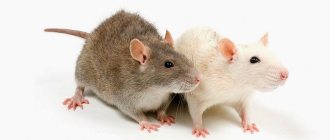If your baby has expressed a persistent desire to have a pet, then it is better to choose a small pet, for example, a rodent. Before purchasing, you should study information about which hamster is best to get, how to arrange its home, how to make it tame and how to care for it.
Don't forget to consult with your children about what color and size animal they want.
It is best to buy a hamster at a pet store, because its employees will tell you about the characteristics of the breed and the rules of care. But not everyone has this opportunity, so this article will discuss which hamster is best to buy so that it becomes a favorite for the whole family.
Which hamster is best for a child?
Children love to watch hamsters stuff their cheeks full of food and carry supplies back to the house. The main burden of care falls on the shoulders of the parents, but the child can be entrusted with minor responsibilities. Changing water or grain will teach responsibility and bring understanding that a hamster for a child is not a toy, but a living being.
Interesting! Psychologists believe that children simply need a pet. Caring for animals teaches them kindness and compassion.
Hamster breed
It is better to choose a hamster according to the age of the child. For children under 5 years old, large breeds are suitable and will not be afraid of a tight hug. It is better for a schoolchild to get a small hamster.
As for colors, you can completely rely on the choice of children:
Important! The life of a dwarf is very short, and children will enjoy their furry friend for a maximum of 3 years.
Boy or girl
The gender of the pet does not really matter if the hamster lives in a cage alone. The behavior of males and females has its own characteristics, but is not fundamentally different. If a family has a couple of different-sex pets, then adults should be prepared for frequent additions to the hamster family.
Interesting! In one litter, from 2 to 9 hamsters are born. But there are cases when a fertile female gave birth to 18 cubs.
The male hamster is larger in size than the female. He very carefully guards his territory, so he constantly marks it. The male's cage must be cleaned frequently to prevent the smell from spreading throughout the apartment. Male hamsters willingly play with children and are trainable.
Females love affection and attention, but they more often have health problems associated with the reproductive organs.
Behavior and contact
A pet for children should be active, sociable and not aggressive. Age and breed are the main criteria when choosing a hamster. Experts recommend buying young rodents that are 1–2 months old. At this age, they no longer need maternal care and easily perceive a change of environment.
Hamsters prefer a nocturnal lifestyle, so it is better to plan a visit to the pet store in the evening. In the morning hours, sleepy rodents are unlikely to seem cute and friendly to their future owners.
A short observation will help determine the pet's character. If he runs randomly around the cage in search of cover, then most likely the animal is scared. Its skin can easily tell about the character of a rodent: fighters have numerous scars on their bodies and heads.
Hamsters, especially Djungarian ones, experience an irresistible urge to wander. They are constantly trying to bite through the bars of the cage, pick the locks, or dig into the cage. Children can be tasked with checking the hamster's house for such surprises.
Interesting! The rodent can be left on its own for 2–3 days. It is enough to take care of a double portion of food in the feeder.
A hamster is a good and devoted friend, the main thing is to teach children to handle the pet carefully.
Housing and diet of the animal
When buying a hamster, take care of its housing. Depending on the size of the animal, a cage or aquarium is selected, inside which a house is installed where the rodent will rest during the day. The floor of the cage is filled with filler, which should be changed 3 times a week. Fluffies are prone to obesity, so immediately purchase special exercise equipment - a running wheel, tunnels and ladders. Hamsters have teeth that grow throughout their lives, so there should be a chalk stone in their home on which they can be ground down.
When looking for a place to install the cage, choose a warm, secluded corner near the radiator and away from drafts. However, it is not recommended to place small rodents in your or your child’s bedroom, since these babies tend to be active at night, which will disturb your sweet sleep.
The rodent's diet should be balanced - proteins of plant and animal origin, cereals, fresh vegetables and fruits. There are quite a lot of special vitamin mixtures sold in stores at an affordable price. It is not necessary to feed animals often, otherwise they will stockpile food, which can lead to poisoning from stale food.
The well-groomed appearance and life expectancy of a hamster, regardless of breed, is entirely your task and that of your children. Teach them to take care of their “little brothers” and your pets will respond with boundless love.
Source
Care and maintenance
Caring for your pet will not take much time. Once every three days it is necessary to change the bedding and remove supplies from the hamster’s house. Feeding is simple: in the morning, just pour grains into the feeder and add clean water.
The list of priority purchases includes:
Important! You cannot feed your hamster fatty meat and milk, mushrooms, exotic fruits, spices, and cabbage. Apricot kernels can be fatal to your pet.
How to choose a hamster for a child
When choosing, you need to pay special attention to the room where the animals are kept. The room should be free of drafts and musty smell. Clean bedding and high-quality food are also the key to rodent health.
Important! Males and females must live in separate cages, otherwise the owners risk receiving numerous offspring several times a year.
A healthy pet will boast velvety fur and sparkling beady eyes. The animal must be picked up, carefully touched and examined. There should be no bumps, abrasions, or inflammation on the animal’s body. It is better not to buy a rodent that has significant discharge from the eyes, nose, or ears.
A young and healthy rodent runs around the cage, climbs into labyrinths, and digs a hole in the litter. Hamsters' activity increases in the evening hours. In unfamiliar hands, the animals sit calmly, but warily. If an animal squeaks, breaks out or bites, then it is unlikely to be tamed.
Children often ask adults to get a hamster, because having a furry friend carries a huge number of advantages. Rodents require much less care than cats and dogs, but teach children responsibility.
Source
Choosing a Syrian Hamster
Perhaps it is absolutely impossible to say that the male is better than the female or vice versa. It all depends on how much effort and care you are willing to put into grooming and taming. Still, there are some differences, which are discussed below.
Boy or girl?
Male hamsters mark territory, so they may have a stronger odor. Experienced owners of these funny rodents claim that if you don’t clean them, the male’s cage will smell strong after 2 days, while the female’s cage will only return to the same state on the 5th or 6th day. Accordingly, males need to be cleaned more often. On the other hand, the owners of females claim that during the period of heat their pets have a strong odor. At other times there is no such problem.
As for which of them is better tamed, a boy or a girl, this is a controversial issue. Hamsters are independent creatures and not as tame as cats or dogs. Therefore, in any case, you will have to spend time and effort to make friends with the rodent. They say that males are more docile, and females are more capricious. As for affection, it depends on your luck.
The most unpretentious pet. Why Syrian and how to choose your gender?
And again the Syrian hamster Khoma settled in my house. So cute, with soft fur, beady eyes, translucent ears and tenacious tiny fingers. And what a cute little pink nose he has. In general, the children quickly persuaded me.
I don’t even remember which hamster this is in my life. I was given my first hamster when I was six years old. I remember crying with joy. He seemed to me the sweetest creature on earth. I took care of him myself, cleaned him. Keeping a hamster is not at all difficult. Ideally, you need a cage with a fairly high tray that is easy to clean, food, and water. You can read about this in specialized literature.
I also had a Djungarian hamster. It is significantly smaller than the Syrian, more nimble and less tame. The Dzungarians live on their own and pay virtually no attention to humans. Suitable for those who like to watch the little independent nimble from the sidelines. The Syrians are more sociable, they even respond to a nickname, they are larger, and slower. You can even train them!
Personally, I didn’t like the specific smell of the dzhungarika’s fur, not strong, but still. Many people claim that Djungarian hamsters do not smell or smell less than Syrian ones, but I don’t agree with this. If you clean it irregularly, the cage will smell, and the fur may become saturated with an unpleasant aroma, regardless of the breed. There is one thing, more on that later. For me, the choice is obvious: if it’s a hamster, then only a Syrian one!
In general, the Syrian hamster is the cutest creature! Easy to maintain, does not require a lot of space and large financial costs. It may well become a wonderful little friend for a child after six years of age and even for an adult.
Source
Which hamster to choose
Hamsters are often given to children to teach them how to care for a pet and instill in them a sense of responsibility. Also, these small rodents are often chosen as a pet by adults who have little free time. Hamsters are unpretentious, do not require much attention and special care, and are easy to keep at home.
To choose a hamster for a child, the final decision must be made by the parents. Children are more interested only in the appearance of the pet. For parents, something completely different is important: is the hamster aggressive, does it bite, how to keep it, is there a smell in the apartment, how often to clean after it.
But at the same time, it is important to listen and take into account the child’s wishes. He should like the pet, and the child should have a desire to look after and care for it.
What are the main differences between hamsters?:
Before getting a hamster, you should study these differences in more detail. It is also worth paying attention to other equally important points.
The lifespan of hamsters at home is quite short. Depending on the species, these rodents live on average 2-3 years. Therefore, in addition to the type and color, you need to decide on the place where to buy a hamster. If you buy a rodent from your hands or at the market, there is a high chance of getting a sick individual that will not live long. Then all efforts are in vain and such an acquisition will not bring joy and happiness. Let's take a closer look at which hamster is best to get and where to buy it.
The Djungarian hamster is the most problem-free rodent + Tips for choosing, What is better than other rodents?
I've had Djungarian hamsters in my life 6 times, now I'm planning to do it again, so I can give some advice to those who are just thinking about getting such a hamster?
girl or boy? what color? There are a lot of advantages, especially compared to other rodents (which I also had - gerbils, guinea pigs; or friends had - rats, Syrian hamsters, rabbits, etc.).
What you need to know before buying a hamster
Yes, dzhungariki really don’t stink!
Believe me, this is true, I had 7 of them (once a couple, the rest singly, of different genders), and I have a super sense of smell. The smell is not strong, it only appears near the cage - only if you do not clean it for a long time. And you can clean the cage no more than once a week, or even less often if you come across a particularly clean homa (usually a female).
They almost always pee in the corner, but it’s better to put a box or jar with sand. But they often poop right in the house, and they like to put the poop on the threshold))) But since they are small, there is no particular unaesthetic, and if the house is on sawdust, then even more so.
Of all rodents, dungarian feces are the most unobtrusive. It's still similar to gerbils, but in my opinion, they poop more.
Character may be different. One of my girls, my favorite, was like a cat, she loved to sleep in her arms, she was even smart and very clean. The other one is frisky. One boy was a kind fool, the other was a biting bastard.
The behavior of a hamster depends on its character, some can sit for a long time in their arms or in their pocket, sleep there, and not pee or poop on people; others are nimble on their hands. You can’t predict in advance, but look when buying - from my experience I can say that the character of the homa (like a child) is visible immediately.
Colors. The main four are standard, sapphire (light gray), pearl (white), tangerine (peach, rare color, hard to find). There are some “subspecies” of colors that differ slightly in shade. But there are no black, black-and-white or red-eyed dwarfs.
Care is minimal, very simple - the simplest of all animals in general. A small cage, sawdust, sand, maybe even hay - you only need a little and it lasts a long time. They also eat little, a little of everything.
It’s convenient to take with you - if you need to leave, in a carrier, jar, or box. Asking someone to look after it is also easy - the animal is small and not troublesome. You can leave him alone even for several days!
At the time of buying. Adviсe
The gender of the hamster is not so important; both the female and the male can have a calm or nimble character - so be careful when choosing.
Be sure to pick up the homa - it should not bite or squeak! Then you'll get tired of taming.
Take the hamster as a baby, a month old - this way he will get used to you better.
Dzungariks are kept only one at a time. Different sexes are mated exclusively for mating.
Take a good look at the photos of the Dzungars on the Internet so that you don’t get sold on the Campbells and Roborovskis, which are much wilder and not for your hands.
Buy a hamster from a professional breeder, and not from home breeding - often hamsters at home appear from a couple that they unknowingly bought at a pet store, are kept together and incorrectly (God forbid, brother and sister at the same time), etc. There is a risk of disease, bad character of such a hamster, etc. My most well-mannered girl was from a professional factory!
Age
One of the most important indicators when choosing a hamster. The older the hamster, the less time it will live with its owner. Also, an adult is more difficult to tame. Adult hamsters take longer to get used to their new place of residence and take a long time to adapt to new conditions.
The optimal age of a hamster is 1-2 months. If you take a hamster that is less than 1 month old, there is a high probability that it will die.
Before deciding on the breed of hamster, you need to decide what gender to choose for your future pet.
Males and females can be distinguished by their behavior. If several individuals are sitting in one cage, then by looking closely you can accurately determine where the female is and where the male is.
Males are slightly larger in size and have a calm disposition. They often act more affectionate and friendly. It is easier to establish contact with a male.
Females are slightly smaller. They are more active, mobile and playful. They do not sit still, constantly running around the cage or rummaging through the litter.
Only individuals of different sexes can be kept in one cage. Same-sex individuals will quarrel and divide territory. They also do not tolerate other types of hamsters on their territory.
But when keeping different-sex individuals, the female will give birth. Such small animals are not sterilized, so the appearance of offspring cannot be avoided. If there are no plans to engage in breeding, then you need to keep one hamster in one cage.
When choosing a male, it is worth noting the disadvantages of keeping it. Firstly, the male has a stronger and more noticeable odor than the female. Secondly, he will mark his territory and his urine will also smell stronger than the female's. Therefore, when keeping males, in order to avoid an unpleasant odor, the cage is cleaned somewhat more often.
Where can I buy?
Having decided on the gender, age and breed of the future pet, a person thinks about where to buy and how to choose the right hamster. There are plenty of purchasing opportunities.
Bird Market
There is a market where all kinds of living creatures are sold in every city. It is strictly not recommended to take a hamster from a poultry market for a number of reasons:
Sick animals are often sold
Market hamsters are stressed and kept in terrible conditions. Overcrowding leads to the spread of infectious and parasitic diseases. If the cage is in a draft, the rodents may catch a cold. Due to savings or oversight, animals sometimes suffer from low-quality feed.
If such a hamster dies after being brought home, it is not possible to complain or return money for the animal.
Invalid data
The seller may lie about the date of birth of the hamsters, and the purity of their blood will remain a mystery. Not to mention the embarrassment when “that fat boy” turns out to be a pregnant girl!
The only argument in favor of the market is the wide choice. You can find a hamster of any breed and color, buy a cage and food.
Pet Shop
In a pet store, animals are more likely to be healthy. Minuses:
The price in the pet store is higher than the market price, but the conditions in which the hamsters are found are more favorable.
Nursery
It is ideal to purchase your future pet from a nursery. The breeder's choice is limited, but you can visit several nurseries. Photos of parent hamsters and litter can be studied in advance on the website.
Hamster breeders understand the issues of caring for these animals like no one else. They have no secrets from customers; many leave a contact number in case of any questions. You can get the contact information of a ratologist from the breeder and consult on feeding.
The birth date of the babies is precisely known; hamsters are sold at the optimal age. Purebred animals are suitable for exhibitions and breeding, although if you are buying a hamster for a child, this is not so important. The cost of “elite” hamsters is high, but the price is justified by the costs of maintaining the nursery.
A very important point is that “domestic” hamsters turn out to be the most affectionate and tame. There are objective reasons for this. Since childhood, they get used to human hands, unlike store-bought ones. They do not experience stress from improper maintenance or transportation. An aggressive or nervous hamster does not receive high marks in the exhibition and is not allowed for breeding.
Therefore, professional breeders receive entire lines of genetically calm and friendly animals.
The hamster has many competitors in the fight for the role of a pet. If you have not yet fully decided on your choice, perhaps our comparison of the hamster with other popular pets will help you.
Hamster breed
The most popular domestic types of hamsters:
Each species has its own individual characteristics. They differ in size, color, behavior and lifespan.
Syrian hamster
The body length is on average 15 cm, some individuals reach 20 cm. Body weight is 100-200 grams. They live on average 2-3 years; many individuals, with good care, can live up to 4 years.
Of all the species, the Syrian hamster is considered the largest. For children 6-8 years old, this type will be the best choice as it is easy to hold. Small species of hamsters are very nimble and can slip out.
The downside is that they take up more space. Large hamsters require a slightly larger cage than smaller species.
According to the length of their fur, Syrian hamsters are divided into:
Choosing a hamster: How to choose and who to choose - female or male - recommendations from the publication "VM"
In this article, the online publication “My Choice” talks about how to choose a hamster, as well as who to choose - a boy hamster (male) or a girl hamster (female), as well as the difference between the content and caring for female and male hamsters and whether it is possible to keep females and males in the same cage.
When choosing a hamster, it is sometimes difficult for future owners to decide who to prefer - a female or a male. If you plan to keep just one pet, then there is no fundamental difference between a boy and a girl, except that males are more patient with the owner’s attention, and females are more clean. In general, since hamsters are creatures that love solitude, gender does not affect the behavior of one individual at all. But when keeping several hamsters, this can become a problem.
To begin with, representatives of most species (except for Roborovsky's hamsters - these get along quite easily) are intolerant of their cage neighbors, even if they are their relatives. The only exceptions are females and males during the mating season, as well as nursing hamsters, who are patient with their own children until the end of lactation. Outside of these periods, the animals prefer solitude. Hamsters of different species perceive each other as their worst enemies, so meetings lead to brutal fights.
Hamsters of different ages and sizes require special attention. Younger and stronger individuals often bully the elderly and sick, and large fluffies will certainly bully their smaller relatives, taking food from them and driving them away from the playground.
It is strongly recommended that hamsters of different sexes living in the same house be kept separately to prevent outbreaks of mutual aggression. Moreover, each hamster needs separate “apartments”, and this creates some difficulties. Agree, if your couple has produced a litter of ten hamsters, then equipping ten separate cages at home will be very problematic.
In addition, you will have to provide a separate cage for mating - you cannot put males in a cage with females, otherwise fights will be inevitable. The fact is that hamsters are very jealous of protecting their territory, so they drive out strangers cruelly and mercilessly. Mating should be carried out only on neutral territory. Considering all these nuances, think carefully about whether it is worth purchasing several fluffies of different sexes. Not every owner will be so patient as to serve as a referee around the clock, separating fighting males and females!
Age of sex determination
It is easier to understand whether a hamster is a boy or a girl after they reach puberty. Gender is mainly determined by external characteristics, and in babies they are invisible, since the genitals are not yet formed. In addition, there is always a risk of damaging them during a careless inspection. And after the procedure, the mother may not accept the child, as a foreign smell will emanate from him.
Important! The optimal age at which you can recognize the sex of a hamster is 3 or 4 weeks after birth. During this period, individuals of different sexes must be placed in different cages, as they will begin to mate or fight for territory. In addition, inbreeding threatens extinction.
Determining the sex of a Syrian or dwarf hamster less than 1 month old is almost impossible. You should schedule an inspection after this time. It is recommended to carry it out together with an assistant: one person holds the animal, and the other conducts the inspection. During manipulation, you need to be extremely careful not to put pressure on the baby.
Adult animals have fully formed genitals, so it will be much easier to recognize their gender. During the examination, you can pay attention not only to the genitals, but also to the shape of the back, the thickness of the coat and other external signs.
Preparing a rodent for examination
Choose a time when the dwarf is calm or sleepy. At this point, he will be less aggressive and will not try to break free. Be sure to pet, caress, and give your pet a tasty treat.
Place the jungarik in your left palm. Then, using the thumb and index finger on your right hand, gently grab the fold of skin between your shoulder blades. This will help secure the rodent so that it does not spin around and bite its owner. Pulling the skin and lifting the pet in this position is prohibited. Carefully turn the animal onto its back. It is ready for inspection.
How is the inspection carried out?
It is important not only to know how to distinguish a girl from a boy hamster, but also to follow the rules of the procedure. Otherwise, you can cause stress to the animal or injure it.
When recognizing the sex of a rodent, you must follow the following recommendations:
After the procedure, you need to pet the pet and release it.
Important! If the hamster is restless and breaks out, then it must be released back into the cage. If a person holds it against its will, it will cause severe stress to the pet, which will most likely begin to bite.
Newly born hamsters should be examined very carefully as they are easily injured. This should be done no earlier than 3–4 weeks after birth.
How to distinguish a boy from a girl hamster
You can find out the gender of a hamster by its characteristic features. They are primary and secondary.
The most reliable signs by which a rodent can be distinguished between a girl and a boy include the study of the genital organs.
A less reliable way to distinguish boy animals from girls is by studying external characteristics. Owners need to pay attention to the size, shape of the back, thickness and length of the fur.
Another way to determine the sex of a hamster is to observe its behavior. It is believed that girls and boys have different characters. However, this method is the least accurate, since their behavior is influenced by various factors, such as age and health.
By gender
It is easier to recognize the sex of a hamster when it is already an adult. The optimal age for examination is from 1.5 to 2 months. The animals' genitals are already fully formed, so there will be no problems with sexual identification.
You can distinguish a girl from a boy by the following signs:
Determining the sex of small hamsters is more difficult than of a sexually mature individual. You should not try to examine the testes of a baby less than 1 month old, as their reproductive organs are still too small.
Interesting! In growing males, you may not notice a bulge in place of the testicles with cryptorchidism. This is a pathology characterized by incomplete descent of the testicles into the scrotum, then they remain almost invisible in the abdominal space.
By appearance
You can distinguish a female from a male visually at a distance. But this is easier to do if hamsters of different sexes live in a group.
Girls and boys hamsters are distinguished by the following characteristics:
You can pay attention to these signs after examining the genitals. They are secondary and help ensure the correct gender identification of hamsters.
Advice from professionals
Experts in the field of breeding Djungarian hamsters give their recommendations for determining the sex of pets.
- Do not try to find out the sex of the jungarik until it is at least three weeks old. Trying to discern sexual characteristics, the owner risks harming the fragile hamster, whose body is still forming.
- To see the genitals, carefully grab the adult animal by the scruff of the neck with your fingers and lift it up. This way the furry pet’s body is in an elongated position, and sexual characteristics become more clearly visible.
- You can try to see the gender in a way that is less stressful for the animal. Place the rodent on its back in your palm and hold it securely, but very carefully with your thumb so as not to hurt. To calm an animal alarmed by such manipulations, you can gently stroke its abdomen, and then the parts of its body of interest will be clearly visible.
- If there is still a need to determine the sex of a small cub, then you can carefully touch it at the location of the genital organs. In boys, small swellings are felt in the groin area - future testicles.
- Pay attention to the size of the pet. Females are usually larger and more plump than their partners.
Observing the behavior of a hamster and noticing its passivity or aggression, you should not draw conclusions regarding gender. Both aggression and excessive calmness are more often associated with the health of the pet. If you notice that the animal has lost its appetite or has begun to bite the owner’s fingers, take the hamster to the veterinarian; perhaps the rodent has caught a cold, has been poisoned, or is experiencing a vitamin deficiency.
Don’t forget to feed your pets properly, change the water daily, clean the cage regularly and let the kids go for walks. And then it is possible to raise a healthy, long-lived hamster or get full-fledged good offspring from him.
You will learn how to determine the sex of a hamster in the video below.
Hamsters are the most popular pets. Everyone is happy to buy them - both adults and children, both for large houses and small city apartments. However, there are still serious discussions going on: what gender of hamster should I prefer? Male or female? After this question appeared in reader mail, we decided to translate a small but capacious and interesting article for you.
Don't worry about your choice, dear readers! Both “boys” and “girls” make wonderful pets! And this is the most important thing! And now - a little about the differences between animals of different sexes.
As a rule, males behave more calmly than females.
Males have thicker and longer fur, sometimes even hanging down to the floor. Of course, there are males with shorter fur, but most “men” will still need your help with periodic combing. For the same reason, carefully select the material from which the cage filler is made. Such as sawdust, for example, can become embedded in the fur of an animal. We recommend aspen shavings or an economical litter made from pressed (chewed) paper. Works great, just needs to be changed more often. But both materials are harmless!
“Girl” hamsters go into heat every four days. The process may be accompanied by a very unpleasant odor, especially in the genital area.
It should also be noted that in dwarf breeds of hamsters, gender differences are much less noticeable to owners.











